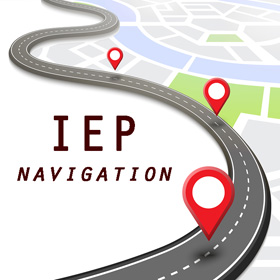 by Lisa DeMarco •
by Lisa DeMarco •
IEP meetings can be incredibly intimidating if advocacy doesn’t come easily to you. I have learned a great deal in the past six and a half years and have been transformed from a “I-never-want-to-rock-the-boat-or-make-anyone-feel-uncomfortable” person to a mom who can speak up for the best interest of her child even when everyone else doesn’t agree. When I leave an IEP meeting, I leave with a plan I am confident in.
The need to be well informed on the IEP process and the law goes without saying, and I encourage you to do your research and enter all meetings prepared in that way. (See box below for information about IEPs.)
In this article, I want to approach the IEP from a more interpersonal angle. IEP meetings involve people who are each looking at your child from a unique perspective, each with their own area of expertise, and each with their own personality and communication style. The goal is to formulate a plan that is specific to your child, that will best meet his or her educational needs. This task will go smoothly at times, but it is unrealistic to expect there won’t be challenges, frustrations, or personality clashes along the way.
Before I continue I want you to know that I have participated in more IEP meetings than I want to count as a parent, but also that I am a team member in over 35 IEP meetings per year professionally in the public school system. My desire is to share some insight into approaches that contribute to identifying and implementing the best educational plan for the children you are advocating for.
Be Honest
Assuming you are already very familiar with the language and the process of IEPs, the first recommendation I have for you is to be honest with yourself about your strengths and weaknesses when it comes to communicating in a group, especially if you have a tendency to feel intimidated or to be intimidating. Remember, the goal is to function as a team, where all members contribute in their area of expertise. You are the expert on your child, even if your child is new to your home. You see the big picture. You have a holistic approach. You understand the effects of trauma and loss. Acknowledge your unique contribution and don’t underestimate it.
Next, acknowledge that each person in the meeting has valuable information to contribute. While you may not agree with all that is stated, listen with interest and then respond with respect, even if you disagree. In my experience, intimidating people are not well received and harshness rarely motivates a person to willingly comply and put forth their best effort.
Be Proactive
You can take steps that can contribute to smoother IEP meetings from the first day of school. Get to know your child’s teacher. Communicate regularly.
I love the idea of writing up a short introduction of your child that you can provide to the teacher(s) the first week of school. Make it a concise summary of what strengths and needs your child has and a few suggestions for how the teacher can help her through tough times.
Have a way of checking in with the teacher if you expect your child to struggle more than usual on a particular day (e.g., due to a parent visit, a nightmare, a medication change, etc.). By doing so you are building a good relationship and establishing yourself as a parent who is involved. (You would be surprised how many parents do not even attend IEP meetings!)
Express appreciation for what is going right. A short note and a small gift (e.g., a candy bar, a travel size lotion) is not necessary, but reminds the recipient there is partnership between school staff and parents/caregivers.
Don’t badmouth the school or teacher in earshot of your child. They are likely to repeat your statements, which could interfere with your child’s felt safety at school.
Ultimately, you want a good relationship with the professionals who are with your child at school, so address and resolve concerns respectfully and without undermining your child’s need to trust those he or she is with each day. If your child has therapies or sees the resource teacher, make sure you have their names and contact information and stay informed and involved with them as well.
On IEP Meeting Days
On the day of IEP meetings, if you are feeling stressed, practice some of the many coping strategies we often remind our children to use. (Yes, moms and dads need those too, and practice makes perfect.)
And just as we should always consider if our children are hungry, thirsty, tired, or need a bathroom break, make sure you don’t forget your own physiological needs as you rush around prior to the meeting. This way you can ensure your full attention will be on your child and not on your discomfort.
Arrive a few minutes early so you are not walking into a room full of people, with no choice of where to sit. Arriving early allows you more flexibility regarding who you sit next to or across from. I generally like to sit next to a person I have a good rapport with, and I avoid sitting across from (and being forced to directly look into the eyes of) team members I clash with.
Remember, you can bring someone to the meeting with you (e.g., a therapist, a friend, an advocate, a specialist); just let the IEP team lead know beforehand.
Sometimes meetings can become heated and stressful. Do your best to remain objective and not overly emotional. In meetings where my emotions got the better of me, I felt others did not consider my input as seriously as when I was able to be objective, factual, and educationally relevant.
There are times when a meeting needs to be continued at a later time (e.g., if no resolution can be met or if there is an unresolved personality clash). Don’t be afraid to recommend that the team adjourn and come together later.
During my first several IEP meetings, I was so nervous and felt intimidated by several people. Having our social worker or therapist attend the meeting gave me confidence to speak up.
In subsequent meetings, I brought printed information on trauma-informed classrooms and handed those out. Eventually I had my children assessed by a psychologist with a focus on childhood trauma and loss, and I made sure the school had an “Educational” copy (i.e., minus information the school did not need to know) of this assessment. I read plenty of resources on foster care, adoption, trauma, and how those affect child development. By doing all this, I became more confident, able to speak up and advocate for my children, and able to be a significant contributor at IEP meetings.
In closing, I would suggest that being informed, prepared, confident in your role as the expert on your child, and respectful at IEP meetings will help you better meet your child’s educational needs. I also have learned that IEP meetings do not need to be painful. In fact, some have actually been enjoyable!
Lisa DeMarco is an adoptive parent in NC.
Parent Involvement Is Key
Parents are expected to participate as equal partners in the IEP process; they must be invited to attend meetings and an IEP must be shown to parents before it can be implemented. For a handbook outlining parent rights related to the IEP process, click here.
In addition to birth parents who retain their educational rights, in North Carolina family foster care parents, guardians, and relatives (e.g., kinship caregivers) who live with the child/youth are legally allowed to fill the parental role in the IEP process. However, a therapeutic foster parent, group home worker, or the DSS worker cannot fill the role of a parent in an IEP meeting (NC DPI, 2014). Guardians ad Litem (GALs) can also serve as a parent in the IEP process if they are appointed to do so by the court (NC DPI, 2008).


